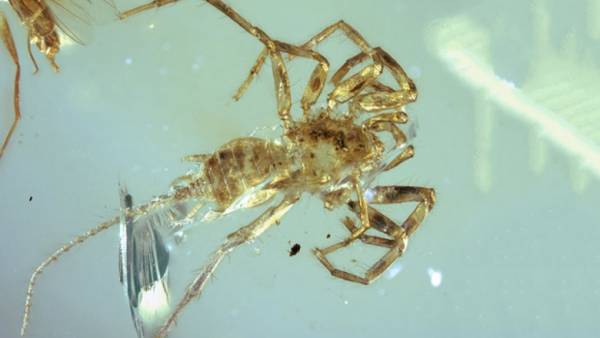In amber found “proto-spiders” with long tails
In Myanmar amber was found well-preserved remains of the arachnids with tails longer than the size of their body. Scientists estimate the age of animals 100 million years and is considered intermediate between the modern rivers and their ancient ancestors.

A study published in Nature Ecology & Evolution as two separate articles. Two copies of the four examined Chinese scholars, the other findings described a group of researchers from Harvard University.
Hunters fossil found in amber unusual creatures that lived 100 million years ago in present-day Myanmar. Ancient arachnids called Chimerarachne yingi by analogy with chimeras — a hybrid of several animals from Greek mythology. The fact that these creatures combine the characteristics of modern and ancient animals. Partially they can see the signs of modern spiders — jaws (chelicerae), nogoshchupaltsa (pedipalpy) and spider glands, additionally they have tails, characteristic of much more ancient relatives of spiders, called uraniidae (Uraraneida). The tail is covered with short hairs, probably originally had a touchscreen function. But when the spiders turned into predators waiting for prey in ambush, he was not needed.
The finding is extremely important for understanding how evolution took place spiders and their relatives. According to scientists, these creatures were the “missing link” between uraniidae and real spiders. They lived in the Cretaceous period when the Earth was inhabited by huge herbivorous argentinosaurus, predatory tyrannosaurs and spinosaurs. Scientists surprised to find, as I did not expect to find such a primitive group of creatures in the fossil record of the Cretaceous period. “The last ten years we believed that the spiders are descended from a tailed spider, which existed more than 315 million years ago,” said study co — author from the University of Manchester, Dr. Russell Garwood.

Scientists suggest that the tiny (a few millimeters in size) proto-spider lived in the trunks of trees or around them, perhaps under the bark or in the moss at the foot of the tree. There is even a small likelihood that the animal still lives in the tropical forests of Southeast Asia. “Remote habitat and small size allow you to assume that the descendants of these creatures still live in Myanmar, where the fossils,” — said Dr. Paul Selden, a paleontologist from the University of Kansas, “We have not found them, but some of these forests is not sufficiently studied”. However, even if these amazing creatures survived, arachnophobes early to panic. According to Gonzalo Giribet zoologist from Harvard University, hardly anyone will find new types of unattractive. “It’s a great being and probably never will cause harm to the person, like 99.99% of spiders”, said Gonzalo.